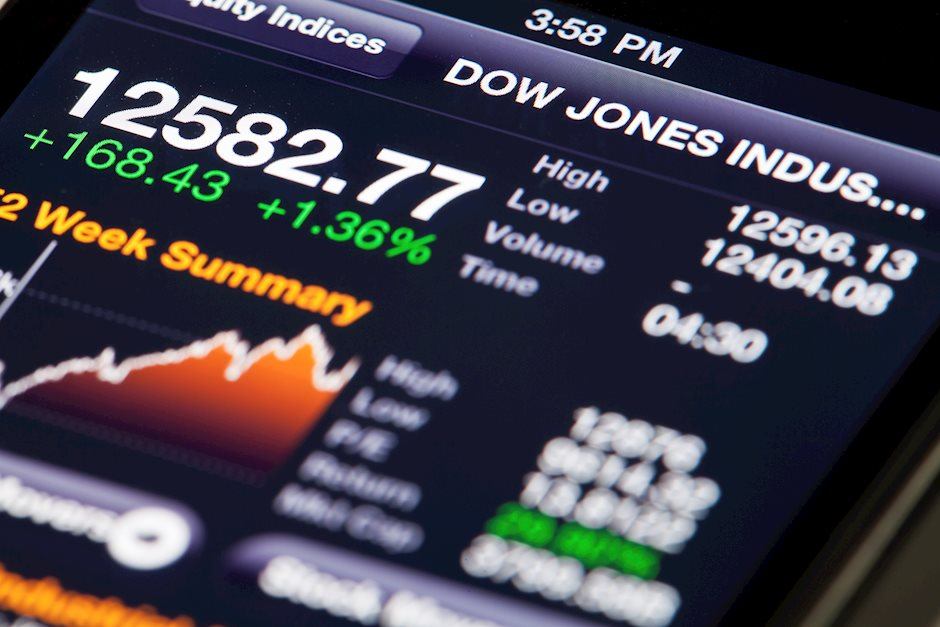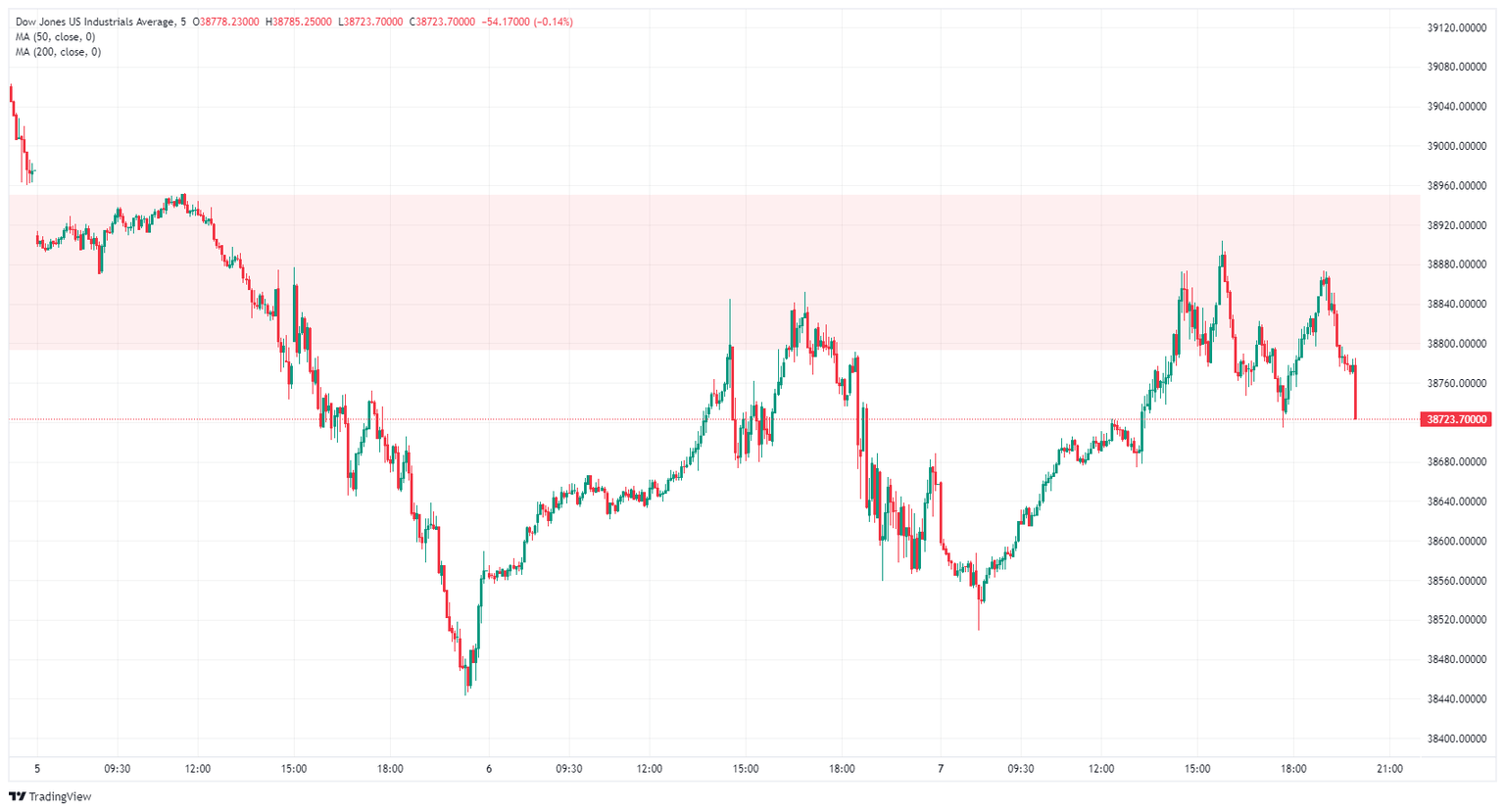Dow Jones Industrial Average Forecast: DJIA gains further ground as Fed's Powell hits familiar beats
- Dow Jones gains, but thinly in easy Thursday trading.
- Fed’s Powell repeat appearance delivers little of note to investors.
- Market focus pivots to Friday’s US NFP jobs report.

The Dow Jones Industrial Average (DJIA) rose a little over a third of a percent on Thursday as investors take the opportunity to bid up equities and readjust their exposure after Federal Reserve (Fed) Chairman Jerome Powell’s second appearance before US government oversight committees produced little of note. Markets are now gearing up for Friday’s US Nonfarm Payrolls (NFP) jobs report.
Fed Chair Powell reiterated most of his statement from Wednesday’s appearance before the US Congressional House Financial Services Committee. Thursday’s Q&A with the Senate Banking Committee largely echoes information the market has already heard. Equities are paring away recent losses, and the DJIA seeks to reclaim the 39,000.00 handle.
Technology stocks led Thursday's bullish tilt in stocks, with the Technology Sector rising nearly 1.9% on the day. The Financial Sector was the market’s soft spot on the day, shedding around a sixth of a percent, while the Real Estate Sector declined by 0.05%.
Dow Jones News: Investors thankful for no Fed surprises turn to focus on US NFP
The DJIA climbed on Thursday but still lagged behind the Standard & Poor’s 500 and NASDAQ Composite indexes, which gained around 1.5% and 1.0%, respectively. Fed Chair Powell’s repeat appearance gave investors little new to chew on, with the Fed head sticking to the “eventually, but not right now” stance on when the Fed might begin cutting interest rates.
Read more: Fed Chair says removing restrictive stance of policy could begin this year
Markets are gearing up for another US NFP print on Friday, and investors expect the February jobs additions to be 200K, down from January’s 11-month peak of 353K new payroll positions.
NFP Preview: Forecasts from 10 major banks, employment continues to rise strongly
Intel Corp. (INTC) is leading the Tech Sector charge on the Dow Jones on Thursday, climbing nearly 4% to trade above $46.00 per share. On the downside, the day’s weakest performer on the Dow 30 is Amgen Inc. (AMGN), falling around 1.75% to trade below $272.00 per share after the biotech company’s board revealed a $2.25 per share dividend. The dividend is slated to be paid out on June 7. AMGN’s stock sees further discounting as Amgen currently holds a Forward P/E ratio of 14.39 compared to the industry average of 22.45 by similar companies in the same sector.
Dow Jones FAQs
The Dow Jones Industrial Average, one of the oldest stock market indices in the world, is compiled of the 30 most traded stocks in the US. The index is price-weighted rather than weighted by capitalization. It is calculated by summing the prices of the constituent stocks and dividing them by a factor, currently 0.152. The index was founded by Charles Dow, who also founded the Wall Street Journal. In later years it has been criticized for not being broadly representative enough because it only tracks 30 conglomerates, unlike broader indices such as the S&P 500.
Many different factors drive the Dow Jones Industrial Average (DJIA). The aggregate performance of the component companies revealed in quarterly company earnings reports is the main one. US and global macroeconomic data also contributes as it impacts on investor sentiment. The level of interest rates, set by the Federal Reserve (Fed), also influences the DJIA as it affects the cost of credit, on which many corporations are heavily reliant. Therefore, inflation can be a major driver as well as other metrics which impact the Fed decisions.
Dow Theory is a method for identifying the primary trend of the stock market developed by Charles Dow. A key step is to compare the direction of the Dow Jones Industrial Average (DJIA) and the Dow Jones Transportation Average (DJTA) and only follow trends where both are moving in the same direction. Volume is a confirmatory criteria. The theory uses elements of peak and trough analysis. Dow’s theory posits three trend phases: accumulation, when smart money starts buying or selling; public participation, when the wider public joins in; and distribution, when the smart money exits.
There are a number of ways to trade the DJIA. One is to use ETFs which allow investors to trade the DJIA as a single security, rather than having to buy shares in all 30 constituent companies. A leading example is the SPDR Dow Jones Industrial Average ETF (DIA). DJIA futures contracts enable traders to speculate on the future value of the index and Options provide the right, but not the obligation, to buy or sell the index at a predetermined price in the future. Mutual funds enable investors to buy a share of a diversified portfolio of DJIA stocks thus providing exposure to the overall index.
DJIA technical outlook
The Dow Jones Industrial Average (DJIA) is struggling to chalk in further ground above 38,800.00 as the index sees intraday technical rejection from a resistance zone priced in from 38,800.00 to 38,950.00. The major equity index is up for Thursday, but gains are looking capped as markets flows pull into the midrange ahead of Friday.
The DJIA is set to etch in a second day in the green after falling for two consecutive sessions, but the index is still down around 1.4% from February’s peak near 39,250.00.
DJIA 5-minute chart

Nonfarm Payrolls FAQs
Nonfarm Payrolls (NFP) are part of the US Bureau of Labor Statistics monthly jobs report. The Nonfarm Payrolls component specifically measures the change in the number of people employed in the US during the previous month, excluding the farming industry.
The Nonfarm Payrolls figure can influence the decisions of the Federal Reserve by providing a measure of how successfully the Fed is meeting its mandate of fostering full employment and 2% inflation. A relatively high NFP figure means more people are in employment, earning more money and therefore probably spending more. A relatively low Nonfarm Payrolls’ result, on the either hand, could mean people are struggling to find work. The Fed will typically raise interest rates to combat high inflation triggered by low unemployment, and lower them to stimulate a stagnant labor market.
Nonfarm Payrolls generally have a positive correlation with the US Dollar. This means when payrolls’ figures come out higher-than-expected the USD tends to rally and vice versa when they are lower. NFPs influence the US Dollar by virtue of their impact on inflation, monetary policy expectations and interest rates. A higher NFP usually means the Federal Reserve will be more tight in its monetary policy, supporting the USD.
Nonfarm Payrolls are generally negatively-correlated with the price of Gold. This means a higher-than-expected payrolls’ figure will have a depressing effect on the Gold price and vice versa. Higher NFP generally has a positive effect on the value of the USD, and like most major commodities Gold is priced in US Dollars. If the USD gains in value, therefore, it requires less Dollars to buy an ounce of Gold. Also, higher interest rates (typically helped higher NFPs) also lessen the attractiveness of Gold as an investment compared to staying in cash, where the money will at least earn interest.
Nonfarm Payrolls is only one component within a bigger jobs report and it can be overshadowed by the other components. At times, when NFP come out higher-than-forecast, but the Average Weekly Earnings is lower than expected, the market has ignored the potentially inflationary effect of the headline result and interpreted the fall in earnings as deflationary. The Participation Rate and the Average Weekly Hours components can also influence the market reaction, but only in seldom events like the “Great Resignation” or the Global Financial Crisis.
Author

Joshua Gibson
FXStreet
Joshua joins the FXStreet team as an Economics and Finance double major from Vancouver Island University with twelve years' experience as an independent trader focusing on technical analysis.

















